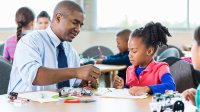A Pandemic Practice to Keep in Science and Math Classes
This year, sharing manipulatives was out for many districts, and one teacher says she won’t go back once the pandemic ends.
Your content has been saved!
Go to My Saved Content.As classroom environments crawl back to an ever-more-normal appearance and teachers across the country relish a return to some dearly missed pieces of our beloved profession (partners! hugs!), one thing sticks out to me that should stay post-Covid: more opportunities for students to work independently with their own set of manipulatives.
As a science, technology, engineering, art, and math (STEAM) teacher who moved heaven and earth (and a lot of antibacterial wipes) to continue to offer rich, hands-on experiences to my in-person students this year, I am really pleased with some of the unexpected advantages that surfaced in a “lab” setting.
I’m a devoted adherent of the tactile and experiential modality, especially for younger students and especially in science. Throughout in-person Covid-era instruction, this meant getting really creative so that every student could have their own materials in hand. There were so many unexpected advantages to this move.
More Hands-On Learning
I’ve always been satisfied with giving each partner pair one set of materials—pre-Covid, this was the acceptable standard, the default. Now that I’ve seen the amazing learning that can come from each student having their own materials, I don’t want to switch back.
When you think about it, even when just two partners share materials, that cuts each student’s hands-on time down to 50 percent, and it’s even less than that if you’re using triples or more in a lab group. So there’s a dramatic positive increase in the minutes of hands-on time each student gets, resulting in much greater learning.
Time spent on harder-to-measure skills is increased as well, like the fine motor practice that comes from manipulating materials, the motor planning piece of executive function, and the building of self-efficacy that comes from more autonomy.
There’s also no chance to hide behind a more capable, assertive, or engaged partner when every single student has their own materials.
I used to be of the opinion that it was helpful to pair more capable students with someone who could benefit from proximity to their good work, but it turns out that there’s a wonderful value to letting everyone stand on their own. I witnessed outstanding growth in tentative students’ ability to develop the resilience and perseverance that would help them reach success in science and across the subject areas, growth opportunities they might not have had if I had continued to “help” by pairing them with a partner.
This resulted in some really beautiful moments when we shared out about our learning. There was new enthusiasm from students who might have taken a back seat in earlier times, and the smart reflections these less assertive students shared helped to elevate them in the eyes of their peers as well, casting new light on the abilities of all in a room that may have been a microphone to the high achievers in the past.
I had access to more accurate informal assessment, too, when every one of my classroom observations was a direct picture of exactly what each student could do. I didn’t incorrectly assume that a partner could or couldn’t do what the other in their group did or didn’t do. Informal room scans yielded more accurate, useful information about who got it and who needed help.
Giving each student their own materials meant making paper copies or being creative about timing by teaming up with another class, pooling the materials, and staggering our teaching times. The Teaching Texan and Math Geek Mama offer many printable manipulatives.
Benefits Outside of Class
Another benefit of paper materials is the sustained interest of students when they bring their materials home. I’ve never given students fraction tiles to keep, for example, but when everyone received paper copies, they could take them home when they were done. I heard from parents about kids who “played school” or taught their younger siblings.
Creative and transformative reuses bubbled up, too—I had several students create artwork. A kindergartner made a collage out of paper triangles that we had been working to describe, and a third grader made a rainbow out of her fraction tiles.
A caveat: It is hugely important that students learn to work together and develop the softer skills of collaboration, sharing, etc. Don’t let their individual items relieve them of the need to practice working together. In my room, this happens many other times each day, so the loss of it in STEAM subjects doesn’t mean it’s gone.
One way to mitigate the loss of communication practice is to facilitate rich reflection conversations as part of the close of your lesson. With my fifth graders, we use a menu of generic reflection questions. We’ve established norms about how students pick questions and about how listeners display attentive body language and ask probing follow-up questions.
In first and second grade, we push students to be evaluative about their experience by awarding three superlatives—not to people, but to a tool or a part of the lesson. As part of our discussion, we name something that was the most effective, the most challenging, and the coolest connection. This keeps our discussion framed in a way that is positive but very constructive and centers the attributes of being efficacious, challenging, and fodder for interesting connections as being of value in our room.
After a lesson about light and shadows, first graders awarded “coolest connection” to a shadow puppet performance they had enjoyed. Second graders taking their first look into a microscope named the 40x magnification objective the “most effective,” as that provided the best view of the insect wings they were investigating.
As we start shaping our next chapter, I’m excited to bring the benefits of individual student resources into my classroom for the long haul!
